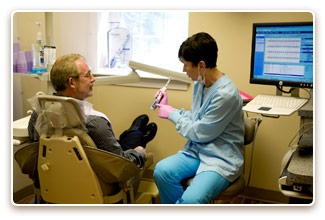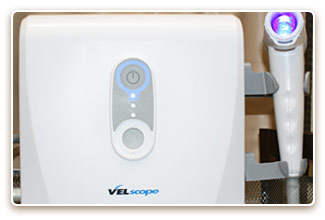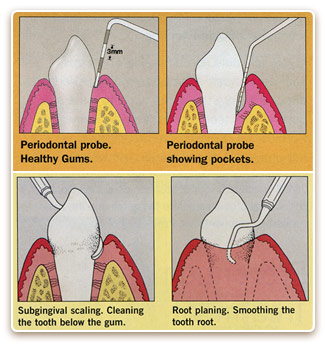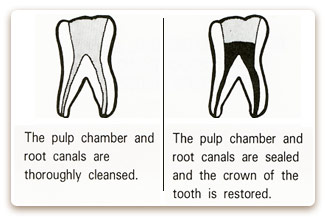Preventive
Comprehensive Dental Exam performed by our dentist includes an examination of diagnostic x-rays essential to determine tooth and root position, detection of decay, tumors cysts, and bone loss. In addition, oral cancer screening, gum disease evaluation, examination of tooth decay and examination of existing restorations are also performed.
Dental Cleanings are performed by our dental hygienist to eliminate plaque and calculus, which form above and below the gumline and can only be removed with special dental instruments. Home care instructions, a tooth brush and other products are also provided.
Digital Radiography is the latest technology in dentistry. Images can be enlarged and contrasted to better detect potential issues. Digital x-rays have 90% less radiation than traditional x-rays.
VELscope examination is an additional oral cancer screening. VELscope emits a safe blue light into the mouth causing the tissue to emit fluorescence. The difference of the fluorescence will highlight any abnormal areas.
Sealants are a thin plastic coating applied to the chewing surface of molars and pre-molars. More then 75% of tooth decay begins in the deep grooves of these teeth.
Flouride is a gel or rinse that is applied to the teeth to help prevent tooth decay.
|


|
 |
Cosmetic
Veneers are custom-made shells, usually made of material such as porcelain, acrylic or composite resins. They can be used to correct discoloration of teeth, close tiny spaces between teeth or reshape teeth. They are attached directly to the tooth, usually without the need of anesthetics. Veneers make it easier than ever to have a great looking smile.
White Composite Fillings restore your natural look. They are mercury free and they require less removal of the tooth structure. The smaller the amount of tooth that has to be removed is vital in keeping your teeth stronger. White composite fillings bond to the tooth and actually restore a majority of the original tooth's strength. This will help prevent your teeth from breaking in the future.
People who use white composite fillings have more confidence in their smile because there is no way to tell that they have had teeth filled. This added confidence can make them more comfortable in social and business settings because by using white fillings, instead of silver, they are improving their appearance.
Teeth Whitening is the most popular and easiest procedure in cosmetic dentistry. Stained or discolored teeth are very common among adults of all ages. Those of us with stained teeth tend to brush more vigorously; this can remove the enamel from your teeth, causing further discoloration and serious dental problems. Over-the-counter whitening kits don't have the prescription strength and lasting effects of a professional teeth-whitening procedure. Our office offers both Zoom, in-office teeth whitening procedure, and take-home whitening kits custom made to fit your teeth.
|
 |
Periodontics
Periodontal disease (or gum disease) is a condition where bacteria attacks the tissues that surround and support the teeth. Gingivitis is the first state of periodontal disease. Plaque irritates the gums, making them tender, inflammed and likely to bleed. If it advances, the plaque hardens into calculus/tartar and the gums begin to recede from the teeth causing gum recession. This results in pockets between the teeth and gums, where more plaque collects and starts destroying gum tissue and bone. A special periodontal treatment, called scaling and root planning, will be recommended, to help prevent teeth from becoming loose, falling out, or needing to be removed.
Warning signs of periodontitis:
• Gums that bleed during brushing
• Red, swollen or tender gums
• Persistent bad breath
• Loose or separating teeth
• Gums that have pulled away from teeth
• Changes in the position or bite of the teeth
Good oral hygiene practices and periodontal cleanings are essential in maintaining dental health and keeping periodontal disease under control.
|
 |
 |
Prosthodontic
Prosthodontics is the dental specialty pertaining to the diagnosis, treatment planning, rehabilitation and maintenance of oral function. Prosthodontic treatments are designed to produce a balance between functionality, longevity and esthetics. They include:
Dental Implants provide a permanent solution to the problem of missing teeth while looking and feeling completely natural. A superior option to both dentures and bridges, especially in instances of multiple missing teeth, dental implants can make your tooth loss worries a thing of the past. In addition to their strength, dental implants are extremely durable and with proper care, dental implants can last a lifetime.
Dental Crowns are all ceramic and gives the tooth a more natural appearance. Porcelain crowns are more often used on front teeth that have decay or prior restorations. They are not strictly for cosmetic purposes, since a substantial amount of original tooth structure is removed before a porcelain crown is placed.
Dental Bridges are a type of restoration that serves as a treatment for missing teeth. A bridge can be either tooth-supported or implant-supported, and is often used as a replacement for a removable denture.
Dentures are dental appliances that are teeth replacements designed for edentulous (toothless) patients. They are removable appliances that are made to closely resemble your own natural teeth. There are complete dentures (for those patients who have lost all their teeth due to trauma or poor oral hygiene) and partial dentures (which replace one or more missing teeth).
|
 |
Endodontics
Root Canal therapy is generally necessary when the pulp (the part of the tooth containing the nerve and blood supply) is damaged or diseased.
This can be caused by a number of reasons:
• bacteria from a deep cavity causes infection
• tooth is injured and the blood supply is ruptured or the nerve is damaged
• tooth is fractured which exposes the tooth to bacteria found in the mouth
• severe gum disease causes infection to the pulp
Root canal therapy involves removal of the pulp tissue and cleaning out the pulp chamber and canals. Once the area has been cleaned, medicine is then placed in the tooth and it is temporarily sealed to prevent bacteria from re-entering the tooth. Then the outer portion of the tooth must be restored.
|
 |
|
